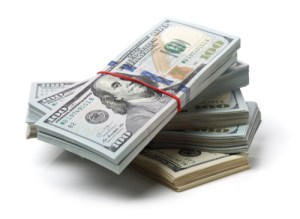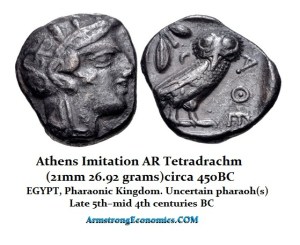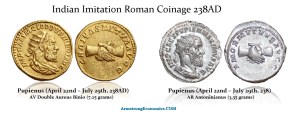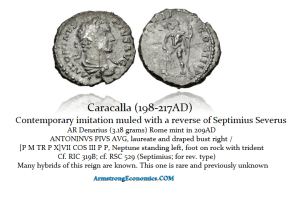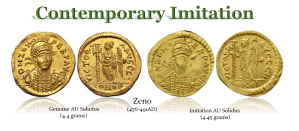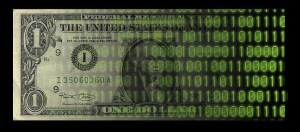What Makes the Dollar the World’s Reserve Currency?
Throughout history there has always been a dominant currency. As each empire became the new financial capital of the world, their currency became the most prized and tended to circulate around the globe into even the fringe economies that they may have never heard of at that moment in time. The dollar is basking in its position as the global reserve currency, for now, but it is crucial to understand what makes a currency the global reserve.
Those who keep preaching the demise of the dollar based on antiquated theories that money must be tangible are living in the old world, where the Earth is still flat. The economy is far more dynamic and has long evolved beyond those primitive ideas. They cannot grasp that since the dollar is the reserve currency, the demand is global and not exclusively domestic.
The United States has NEVER canceled its currency, which is part of what makes it the reserve currency. People crave the USD throughout the world and 70% of physical cash is held outside the country. There is safety in the dollar in comparison to other currencies. It would be a monumental problem to cancel the dollar internationally. I can only see that occurring through war or an event that destabilizes America’s position as the leading global super power.
The title of “reserve currency” has shifted throughout human history. Hence, why we see countless empires and nations imitating currencies. We have discovered ancient Roman coins made in China and there was even the attempt to establish diplomatic relations with China in 180 AD, as the Chinese historical records prove. Rome was very much like the United States today. It was the largest world economy with a huge consumer base. There are countless examples of imitated coinage throughout history.
Rome feasted on Asian imports of spices and fine silk. The Silk Road predates Rome. The emperor would not allow anyone to wear the color purple, also an import from Asia. There was trade between East and West well before the rise of the Greeks. This is why we find imitations of Greek and Roman coins made in distant lands. These are not attempts to counterfeit but to expand the local supply of such foreign coins that became popular.
The US dollar has filled that same role. When communism fell, dollars became Russia and China’s number one circulating medium of exchange. There were even Congressional hearings on the exportation of dollars to foreign lands. History repeats because the passions driving mankind never change.
It became the dollarization of the world economy just as it had been in ancient times with every dominant economy. The dollar became globalized in part because the US never canceled its currency, as was the routine case in Europe. Why have nations canceled their currencies? Primarily to force citizens to come forth with all they have and force them to pay more in taxes.
Dollars were shipped out of the United States in record amounts, not only through transactions in the drug trade and illegal economy but also through the Federal Reserve Bank of New York, in collaboration with Citibank and Republic National Bank of New York of Edmond Safra. The US supply of physical dollar bills was $348 billion, but the hoopla was claiming $190 billion had left the United States. Prior to the collapse of communism in 1989, the amount of dollars outside the US in physical form was about $80 billion.
At the time, about $20 billion in physical US dollars were in Argentina as people there did not trust the government and preferred dollars. Dollars accounted for 70% of Bolivia’s money supply during the 1980s. Dollars were being hoarded everywhere. They were in the black market in Vietnam for nearly a decade after the Americans left. Business Week Magazine reported in its Aug. 9, 1993 issue that there may be as many as $20 billion in physical US dollars in Russia. All of this was cast as some giant conspiracy of the United States to take over the economy somehow worldwide. The imagination knows no bounds.
The United States wants to eliminate cash so it can collect every penny it imagines is missing from its revenue expectations. If we are ever going to revise the world monetary system, we have to stop the nonsense of picking pieces from history to support predetermined ideas and just follow the facts to understand how this functions. The Marxist approach was to dictate how the economy should function in his mind and force that to take place by political decree.
Keynes adopted that concept, and it is still with us today, manifesting in every corner based upon predetermined biases. Keynesian economics is DEAD. The dollar is by no means going to fade away. China will not immediately replace the dollar as a reserve currency until debt is no longer used as reserves by nations. There is a separate and distinct difference between the currency being used in trade and the currency being used to store wealth. They do not have to be the same thing; they are entirely two different animals.
Until debt ceases to be money that pays interest, the dollar will not vanish as a reserve currency. Even when China becomes the largest economy, it will not displace the “reserve” status of the dollar until there is a deep market to park cash. That is separate and distinct from trade being conducted in a variety of currencies. We MUST revise the world monetary system. When we reach that point, then we can deal with creating an alternative for a “reserve” currency that is entirely distinct from trade currencies.
